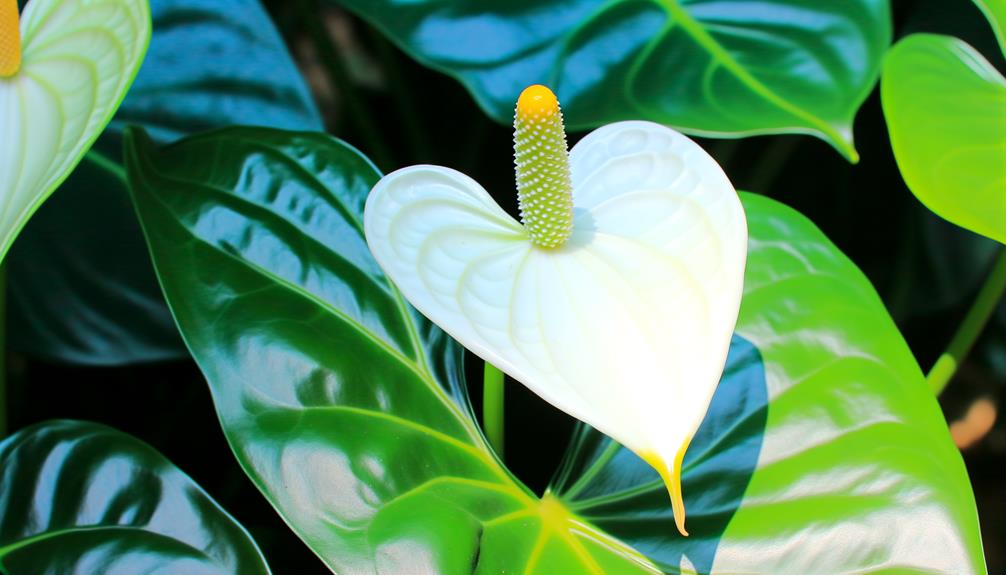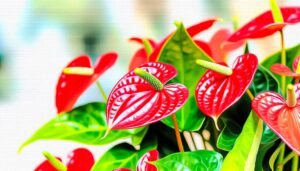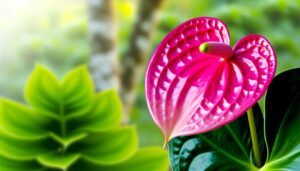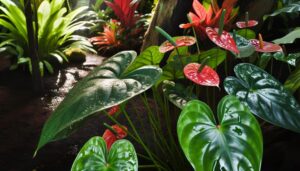What Unique Features Does the Anthurium White Flamingo Flower Have?
The Anthurium White Flamingo Flower (Anthurium andraeanum) is noted for its striking white spathes, modified leaves that encase the inflorescence and attract pollinators with specialized pigments. Its glossy, heart-shaped leaves feature a waxy cuticle and prominent venation, enhancing longevity.
The plant's vibrant yellow spadices, containing carotenoid pigments, house stamens and pistils essential for reproduction. Additionally, this species is renowned for its air-purifying abilities, absorbing VOCs like formaldehyde to improve indoor air quality.
Lastly, its long-lasting blooms and robust cellular structure allow for extended display periods. More intricate details of its biology can reveal further fascinating aspects.

Key Takeaways
- Striking white spathes with waxy texture encase the inflorescence, enhancing ornamental appeal.
- Glossy, heart-shaped leaves with prominent venation patterns aid in nutrient transport and support.
- Vibrant yellow spadices, rich in carotenoid pigments, attract specific pollinators and facilitate pollination.
- Air-purifying abilities absorb VOCs like formaldehyde, xylene, and ammonia, improving indoor air quality.
- Long-lasting blooms with durable, thick spathes maintain structure and color for several weeks.
Striking White Spathes
The Anthurium White Flamingo Flower, scientifically known as Anthurium andraeanum, is distinguished by its striking white spathes, which serve as a modified leaf that encases the inflorescence. These spathes, primarily composed of a waxy, durable texture, contribute significantly to the plant's ornamental appeal.
The spathes are essentially protective structures that envelop the spadix, a cylindrical spike where tiny flowers are densely packed. The white coloration of the spathes is a result of specialized pigments and cellular structures that reflect light, enhancing visual purity.
Additionally, the spathes play a crucial role in attracting pollinators and shielding the reproductive organs from environmental stressors. This unique morphological adaptation underscores the Anthurium's evolutionary advancements in reproductive success and survival.
Glossy Heart-Shaped Leaves
Boasting a remarkable sheen, the heart-shaped leaves of Anthurium andraeanum display a vibrant green shade, contributing to its aesthetic and functional traits.
These leaves, often called 'laminae,' are both wide and cordate, measuring up to 20 cm in length. The shiny surface is due to a waxy cuticle layer, which not only enhances visual appeal but also minimizes water loss through transpiration, aiding in the plant's overall water efficiency.
The leaves' venation pattern, consisting of prominent, parallel veins, ensures ideal nutrient and water transport. Additionally, the petioles are sturdy, providing significant support to the laminae, preventing damage from environmental stressors.
This combination of structural and physiological features highlights the plant's adaptability and longevity.
Vibrant Yellow Spadices
Characterized by their striking chromatic display, the vibrant yellow spadices of *Anthurium andraeanum* serve as a focal point in the plant's reproductive structure. These spadices are not merely ornamental; they play a critical role in the pollination process, acting as the primary sites for both male and female reproductive organs. The inflorescence comprises numerous tiny flowers arranged in a spiral pattern along the spadix.
- Pigmentation: The yellow hue results from carotenoid pigments, enhancing visual appeal.
- Texture: Smooth, cylindrical structure, facilitating pollinator access.
- Functionality: Houses both stamens and pistils, enabling self-pollination.
- Longevity: Persistent for several weeks, supporting extended pollination periods.
- Adaptation: Attracts specific pollinators like bees and beetles through its vivid coloration and mild fragrance.
Air-Purifying Abilities
Beyond their visually enchanting spadices, *Anthurium andraeanum* also exhibits significant air-purifying abilities, contributing to indoor air quality improvement through the absorption of volatile organic compounds (VOCs) such as formaldehyde, xylene, and ammonia. These compounds, often emitted from household items like paints, varnishes, and cleaning products, pose potential health risks.
The *Anthurium* plant utilizes its foliage to absorb these pollutants during the process of photosynthesis, effectively converting harmful substances into less toxic byproducts. Additionally, the plant's large, glossy leaves provide a substantial surface area for the absorption process, enhancing its efficiency.
This attribute makes *Anthurium andraeanum* not only an aesthetic addition but also a functional element in maintaining healthier living environments.
Long-Lasting Blooms
*Anthurium andraeanum,* renowned for its enduring inflorescences, produces blooms that can last up to several weeks, outlasting many other ornamental plants. This remarkable longevity is attributed to the plant's physiological and anatomical adaptations, making it a staple in both horticultural displays and floral arrangements. The white spathes maintain their structure and color for extended periods, providing continuous aesthetic appeal.
Key features contributing to the long-lasting blooms include:
- Thick, waxy spathes: Resilient to desiccation and physical damage.
- Robust cellular structure: Enhanced durability and extended viability.
- Efficient water retention: Minimizes wilting and dehydration.
- Low metabolic rate: Reduces senescence rate for prolonged freshness.
- Resistance to pathogens: Mitigates decay and infection, ensuring longevity.
These characteristics underscore the Anthurium White Flamingo's exceptional durability.
Conclusion
The Anthurium 'White Flamingo' displays distinctive characteristics such as stunning white spathes, shiny, heart-shaped leaves, and bright yellow spadices.
Its air-cleansing abilities, primarily by eliminating volatile organic compounds (VOCs), enhance indoor environmental quality.
The enduring blooms, thanks to the plant's strong physiology, guarantee prolonged periods of decorative exhibition.
This blend of visual attractiveness and practical advantages reinforces the idea that Anthurium species are valuable both as decorative and air-purifying indoor plants.






